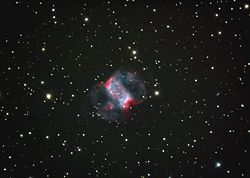- Little Dumbbell Nebula
-
Little Dumbbell Nebula 
Observation data
(Epoch J2000.0)Right ascension 01h 42.4m Declination +51° 34′ 31″ Distance 780 pc or 2,500 ly Apparent magnitude (V) +10.1 Apparent dimensions (V) 2.7 × 1.8 arcmin Constellation Perseus Physical characteristics Radius 0.617 ly Absolute magnitude (V) +10.1 Other designations M76, NGC 650/651 See also: Planetary nebula, Lists of nebulae The Little Dumbbell Nebula, also known as Messier 76, NGC 650/651, the Barbell Nebula, or the Cork Nebula,[1] is a planetary nebula in the constellation Perseus. It was discovered by Pierre Méchain in 1780 and included in Charles Messier's catalog of comet-like objects as number 76. It was first recognised as a planetary nebula in 1918 by the astronomer Heber Doust Curtis. However, there is some contention to this claim, as Isaac Roberts in 1891 did suggest that M76 might be similar to the Ring Nebula (M57), being instead as seen from the side view.[2] The structure is now classed as a bipolar planetary nebula (BPNe).[3]
Distance to M76 is currently estimated as 780 parsecs or 2,500 light years ,[4] making the average dimensions about 0.378 pc. (1.23 ly.) across.[5]
The total nebula shines at the apparent magnitude of +10.1 with its central star or planetary nebula nucleus (PNN) at +15.9v (16.1B) magnitude.[1] The UV-light from the PNN is expanding outer layers that form the present nebula, and has the surface temperature of about 88,400 K. The whole planetary nebula is approaching us at −19.1 km.s−1.[6]
The Little Dumbbell Nebula derives its common name from its resemblance to the Dumbbell Nebula (M27) in Vulpecula. It was originally thought to consist of two separate emission nebulae and was thus given two catalog numbers in the NGC 650 and 651. Some consider this object the faintest and hardest to see objects in Messier's list.
See also
- Messier object
- List of Messier objects
- New General Catalogue
- List of planetary nebulas
References
- ^ a b "M 76 -- Planetary Nebula". SIMBAD. Centre de Données astronomiques de Strasbourg. http://simbad4.cfa.harvard.edu:8080/simbad/sim-id?Ident=%4084066&Name=M%20%2076&submit=submit. Retrieved 2010-01-25.
- ^ "Messier 76". The SEDS Messier Catalog Webpages. http://messier.obspm.fr/m/m076.html. Retrieved 2010-01-25.
- ^ Philips, J.P.; Phillips, J. P.; Cuesta, L. (2008). "The visual and mid-infrared properties of the bipolar planetary nebula NGC 650-1". Monthly Notices of the Royal Astronomical Society 391 (1): 52–62. Bibcode 2008MNRAS.391...52R. doi:10.1111/j.1365-2966.2008.13886.x.
- ^ Philips, J.P. (2005). "The distances of highly evolved planetary nebulae". Monthly Notices of the Royal Astronomical Society 357 (2): 619–625. Bibcode 2005MNRAS.357..619P. doi:10.1111/j.1365-2966.2005.08676.x.
- ^ Philips, J.P. (2002). "The Distances of Planetary Nebulae: A Scale Based upon Nearby Sources". Astrophysical Journal Supplement Series 139 (1): 199–217. Bibcode 2002ApJS..139..199P. doi:10.1086/338028.
- ^ Philips, J.P. (2002). "The Distances of Planetary Nebulae: A Scale Based upon Nearby Sources". Astrophysical Journal Supplement Series 139 (1): 201. Bibcode 2002ApJS..139..199P. doi:10.1086/338028.
External links
- NightSkyInfo.com - M76, the Little Dumbbell Nebula
- Little Dumbbell Nebula (M76, NGC 650 and 651)
- The Little Dumbbell Nebula on WikiSky: DSS2, SDSS, GALEX, IRAS, Hydrogen α, X-Ray, Astrophoto, Sky Map, Articles and images
- The Little Dumbbell Nebula @ SEDS Messier pages
Messier objects List M1 · M2 · M3 · M4 · M5 · M6 · M7 · M8 · M9 · M10 · M11 · M12 · M13 · M14 · M15 · M16 · M17 · M18 · M19 · M20 · M21 · M22 · M23 · M24 · M25 · M26 · M27 · M28 · M29 · M30 · M31 · M32 · M33 · M34 · M35 · M36 · M37 · M38 · M39 · M40 · M41 · M42 · M43 · M44 · M45 · M46 · M47 · M48 · M49 · M50 · M51 · M52 · M53 · M54 · M55 · M56 · M57 · M58 · M59 · M60 · M61 · M62 · M63 · M64 · M65 · M66 · M67 · M68 · M69 · M70 · M71 · M72 · M73 · M74 · M75 · M76 · M77 · M78 · M79 · M80 · M81 · M82 · M83 · M84 · M85 · M86 · M87 · M88 · M89 · M90 · M91 · M92 · M93 · M94 · M95 · M96 · M97 · M98 · M99 · M100 · M101 · M102 · M103 · M104 · M105 · M106 · M107 · M108 · M109 · M110See also Categories:- Messier objects
- NGC objects
- Perseus constellation
- Planetary nebulae
- Orion arm
Wikimedia Foundation. 2010.
